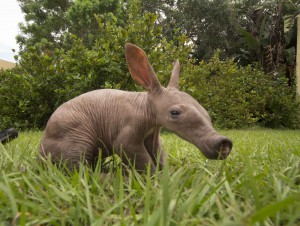Baby Aardvark born at Busch Gardens
A newborn aardvark at Busch Gardens® Tampa is stealing the hearts of its caretakers, who are helping bottle feed the baby, which they characterize as unusual looking but adorable.
The baby aardvark was born Sept. 18, 2015. It is healthy and is currently being cared for by its mother Izzy. While mother Izzy forages at night, the Busch Gardens animal care team bottle feeds the baby and monitors its health through routine check-ups.
This is Busch Gardens’ fifth successful aardvark birth and is part of the park’s participation in the Association of Zoos and Aquariums’ Species Survival Plan.
Newborn aardvarks are sometimes referred to as “ugly cute” with elongated noses, large floppy ears and hairless, wrinkly skin. After two weeks, the folds of skin disappear and, around three weeks, the ears will begin to stand upright.
The baby’s sex will be determined within the next few weeks, along with the team’s decision on a name.
The mother and baby are currently behind-the-scenes at Busch Gardens. The baby will be part of Busch Gardens’ animal ambassador program, helping to educate guests about this species and their counterparts in the wild. Get the first look at the baby aardvark on Busch Gardens’ YouTube channel.
Busch Gardens is owned and operated by SeaWorld Parks & Entertainment™, a leading theme park and entertainment company that delivers personal, interactive and educational experiences that blend imagination with nature. SeaWorld Parks & Entertainment is best known for its 11 U.S. theme parks, attractions that hosted more than 24 million guests in 2012. Each of these theme parks offers a distinct entertainment experience that connects guests to the world and to one another.
SeaWorld Parks & Entertainment™ also is one of the world’s foremost zoological organizations and a worldwide leader in animal welfare, training, husbandry and veterinary care. The company collectively cares for one of the largest animal collections on the North American continent and has helped lead advances in the care of species in zoological facilities and in the conservation of wild populations.


